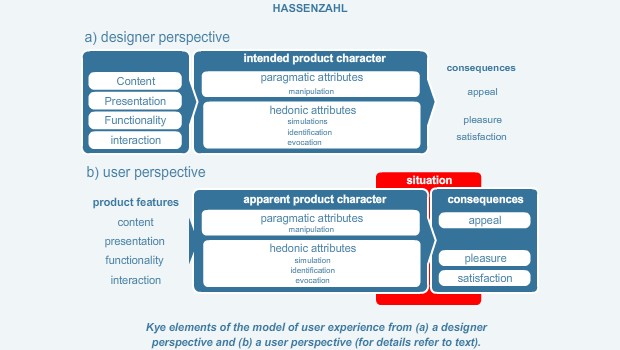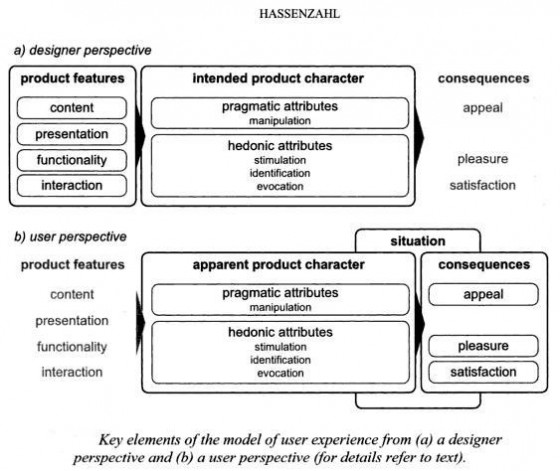In my last post about Hassenzahl’s model, we looked at how users assign attributes to the product or service experience. These attributes differ from user to user, and hence each user has an unique experience with the product/service. As the graphic shows, the model suggested that user experience is actually a result of these attributes and the situation in which the product or service is utilized. The model’s four attribute categories – manipulation, identification, stimulation and evocation are grouped further into Pragmatic and Hedonic groups.
The pragmatic attributes are about the practical usage and functions/features of the product/service. The hedonic attributes relate to the user’s psychological well-being. The divide actually relates to how I may design a product’s user experience; but it also suggests (as I mentioned in my previous post) that one cannot really design the ‘user experience’ itself. Hassenzahl uses a hammer as a metaphor to explain the difference between pragmatic and hedonic attributes in his book. For a hammer – its pragmatic attribute is directly tied to whether and how it can be ‘used’, i.e., its function. A hammer could also have hedonic qualities; for example if used to represent tools or to bring back memories of carpentry class, etc. Essentially, the pragmatic attributes relate to functionality and the ways those functions/features can be used. It’s mainly about ‘manipulation’, as the user navigates and uses the functions/features. As Hassenzahl explains, one of the consequences of pragmatic qualities is user satisfaction. In a sense, manipulation is a very important attribute that contributes significantly to user experience in a product like an elearning course. In that context, we must ask, do using courseware or learning tools lead to a sense of satisfaction in the user? Another attribute a product like courseware could have in addition to ‘manipulation’ is ‘Identification’. Identification is what makes us choose products/services that align closely to our perception of self. In social situations, one’s individual nature and tastes can be identified by our product service choices. This is because we use products/services/objects to express ourselves. This is a secondary function – to communicate your identity to others. Products/services like Facebook, Myspace, Twitter, etc. allow us to communicate to the world-at-large who we are and what we – meeting the identification attribute from Hassenzahl’s model very well. In the eLearning context, it’s sad, this is where a LOT of our courseware products fail miserably. The typical elearning course tends to be one-off, minimally functional product, which allows very little customizability on the part of the user (learner). There is absolutely no way most learners will ‘identify’ with such courseware; it does very little to help ‘identification’. Stimulation is another attribute that is rarely seen in elearning courseware. When was the last time you took an electronic course a few times and discovered something new about it each time. In most situation, you can do a course a couple of times, at most three; beyond that there is very little novelty left in the course. On the other hand, compare this with software like MS Word or Excel. Every now and again, while using these, we discover hidden features, or discover a new way to accomplish a routine task; we have what can be termed software use ‘aha’ moments. Typically when I encounter such a feature, my instant reaction is ‘cool’ or ‘this is great’ or something along those lines. This tends to reinforce my software usage, because I never know when I may run into another cool feature. It’s also the simple human urge to improve skills. I like products/services that reinforce the hedonic attribute of stimulation, something elearning courseware does not do. Another attribute included in the model is ‘evocation’. This is quality that causes products/services to elicit particular memories of past experiences. We often choose products/services on the basis of this attribute. It’s like the broken grand-father clock in my kitchen, it has no ‘pragmatic’ ‘manipulative’ quality, it’s broken and doesn’t work. Yet I continue to hang it up on the wall, because it evokes memories of my grandfather and the time I spent with him as a child. eLearning is rarely evocative; perhaps the only example I’ve seen of evocative eLearning was the use of black/white/sepia toned imagery and a 30s theme for a course that delved into the product history of a large corporation. I wonder what other ways can make eLearning evocative. As elearning designers we must ask, am I leaving the learner with a memorable user experience. We must ask, does the courseware allow for manipulation, will the learner identify with it, will it stimulate the learner, and will it be evocative?




















